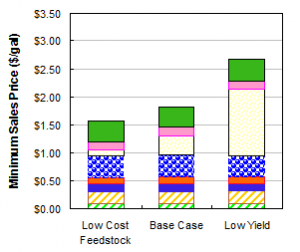Economic Analysis

Economic Modeling
Alternative energy processes need to be economically viable at commercial volumes in order to warrant investment or even government funding in pilot plant research. With that in mind, critical questions come up for your production process:
-
Do you know the economics of your process at scale?
-
What are the costs of compressors, reactors, materials handling equipment at 100 times your current scale?
-
How will feedstock costs and transport costs vary with plant size?
-
What is the role of GHG incentives and carbon credits?
Our life cycle and economic modeling can help guide your capital investment decisions to compete in a carbon constrained economy.
Cost Comparison

Our economic analyses of energy systems include:
Process Optimization
The revenue from fuel production processes depends on the energy inputs and yields. Our process modeling helps optimize fuel and material production processes to obtain the best environmental footprint as well as revenue from products and co-products.
Investment Analysis
The economics of many new energy projects depend on the value of GHG credits that are tied to different feedstocks and markets. We help evaluate investment decisions by screening the GHG analysis for new projects, reviewing feedstock options, and end use markets.
Macro-Economic Analysis
The environmental, economic, and employment impacts of a new technology depend on the overall impacts on the economy including the displacement of other technology, direct, indirect, and induced economic effects. We work with a team of economic experts to asses the global implications of indirect land use conversion, displacement effects of new facilities, and related economic effects using a range of tools including macro-economic models such as GTAP, supply curves for energy and chemicals, and analysis of government policies.
Co-product Markets
We analyze the economic outlook of co-product markets from your production process as potential for additional income streams.
GHG Credit Strategy
Many fuel production technologies benefit from incentives such as the LCFS and RFS. The outlook for LCFS credits, RINs, and other incentives depends on the structure of regulatory programs as well as the supply and demand of feedstocks and fuels. Our data on the most recent new energy projects provides the basis for developing supply
curves for the LCFS credits and other incentives. This data provides a valuable tool for risk mitigation for new energy projects.
